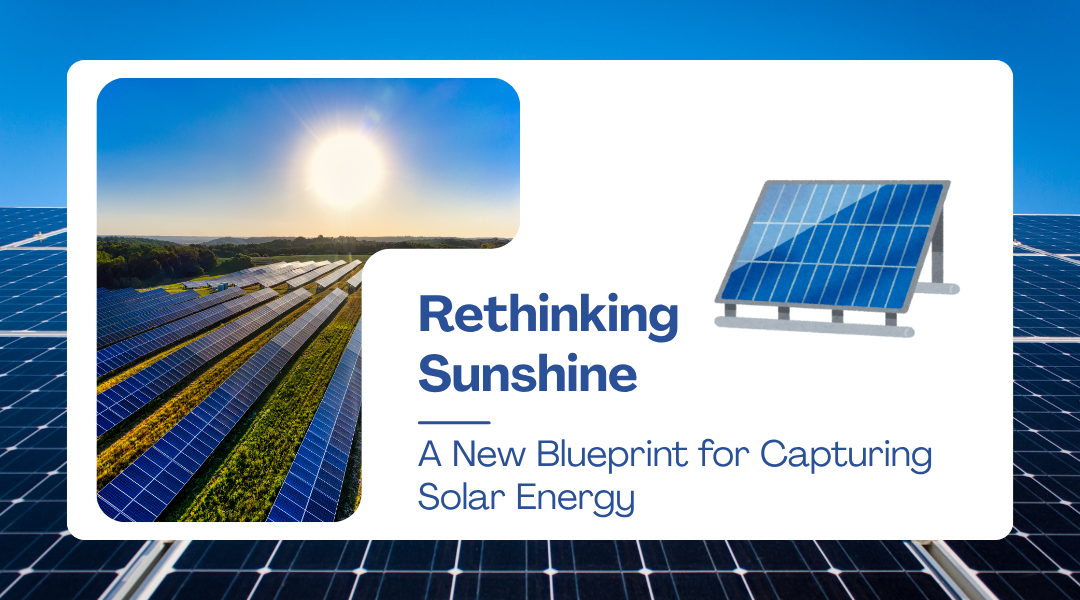For decades, the story of solar power has been written in silicon. Photovoltaic panels, the workhorses of the clean energy revolution, operate on a straightforward principle: they catch photons from sunlight and convert them into an electric current. It’s a marvel of modern engineering, but it has a fundamental blind spot. Our current solar cells are like picky eaters at a grand buffet; they only consume a narrow portion of the light spectrum, leaving vast amounts of potential energy on the table.
What if we could redesign the dinner table itself? Imagine a new generation of solar technology that doesn’t just accept the sun’s light as it is, but actively tailors it for optimal consumption. This isn’t a minor efficiency tweak—it’s a fundamental reimagining of how we harvest sunlight.
The Core Idea: A Solar Translator
The limitation of traditional panels lies in their “bandgap.” Simply put, the semiconductor material inside them is tuned to absorb only a specific range of light energy, primarily in the visible spectrum. The high-energy ultraviolet photons and the low-energy infrared waves largely pass through unused, representing a massive lost opportunity.
The proposed solution is what we might call a “solar spectrum translator.” Instead of a passive absorber, think of a future solar panel as an intelligent, active system. Its core function would be to take the “inconvenient” frequencies of sunlight—the ones the core cell can’t use—and transform them into the “ideal” frequencies it craves. This process would unlock the full potential of every ray that hits the surface.
Building the Translator: Four Pillars of a New Technology
Turning this concept into reality hinges on cutting-edge advances in material science. Here’s how we could build it:
- The Nano-Scalpel: Precision Engineering of Light
At the heart of this system would be nanostructured materials acting as tiny frequency shifters. Think of them as microscopic translators for light. Their job is to take a high-energy ultraviolet photon and carefully split its energy into two lower-energy photons that the solar cell can easily absorb—a process known as “down-shifting.” Conversely, they could combine two low-energy infrared photons into a single, more potent one, a trick called “up-conversion.” This ensures no energy packet is too big or too small for the system to process. - The Quantum Tuners: Custom-Built Light Catchers
We could integrate quantum dots—nanoscale crystals that behave like artificial atoms. Their magic is their tunability; by altering their size, we can program them to absorb specific, “useless” colors of light and re-emit them as the exact “useful” color that the underlying solar cell is designed to convert most efficiently. It’s like having a team of specialists who repackage unsellable goods into bestsellers. - The Light Benders: Steering Sunshine with Metamaterials
Imagine a panel surface that doesn’t just let light hit it, but actively guides and traps it. Metamaterials—engineered structures with properties not found in nature—could make this possible. Designed with intricate patterns, these materials could bend incoming light waves, twisting and focusing them to travel longer paths within the cell. The longer light lingers, the higher the chance it will be absorbed and converted, dramatically boosting efficiency even with indirect or weak light. - The Energy Amplifiers: Harnessing Electron Ripples
Finally, we can employ plasmonics. By embedding tiny metallic nanostructures, we can create ripples of energized electrons (plasmons) that resonate with specific light frequencies. These resonances act as intense, localized energy hotspots, concentrating the sun’s power right at the spots where the conversion to electricity happens, supercharging the panel’s absorption capabilities.
The Ripple Effects: Why This Matters
Adopting this holistic approach would trigger a cascade of benefits far beyond a simple percentage point gain in efficiency.
- All-Weather, All-Hour Power: By efficiently harvesting diffuse light and non-visible spectra, these panels would generate significant electricity on cloudy days, in the early morning, and late afternoon. This smooths out power generation, reducing reliance on perfect sunshine and making solar a more reliable backbone for the grid.
- Ubiquitous Solar Integration: When panels become highly efficient and able to work in low-light conditions, we can integrate them into entirely new surfaces. Imagine the glass of a skyscraper, the paint on your car, or the fabric of a backpack becoming a subtle yet powerful energy generator, blending seamlessly into our environment.
- Leapfrogging Theoretical Limits: This technology has the potential to shatter the theoretical efficiency ceiling for single-junction silicon solar cells (the Shockley-Queisser limit), opening a path to performance levels we currently consider impossible.
The Road Ahead: Challenges to Overcome
The vision is compelling, but the path from lab to rooftop is steep.
- Manufacturing Marvels: Fabricating these complex nanostructures and metamaterials with atomic precision at a commercial scale is a monumental engineering challenge. It will require breakthroughs not just in design, but in production technology.
- The Cost Equation: Advanced materials and intricate manufacturing processes are expensive. The ultimate success of this technology will depend on driving down costs to a point where the significant efficiency gains justify the initial investment.
- The Greenness of the Machine: We must conduct a full lifecycle analysis. Are the new materials sustainably sourced? Are they recyclable? The environmental footprint of producing and decommissioning these advanced panels must be far less than the clean energy they produce over their lifetime.
Conclusion
We stand at a crossroads in solar technology. While refining our current silicon-based panels is essential, the next great leap will come from a paradigm shift—from passive collection to active spectrum management. By learning to translate the full, rich language of the sun’s energy, we can move beyond the limitations of our first-generation hardware. This journey into advanced materials and light manipulation promises a future where solar energy is not just an alternative, but a ubiquitous, highly efficient, and seamlessly integrated foundation of our energy system. The blueprint is now on the table; the task ahead is to build it.
